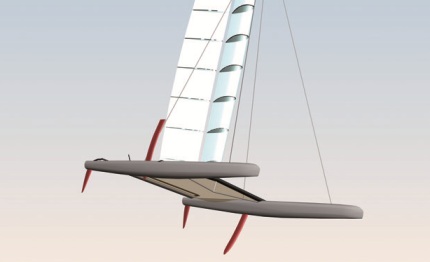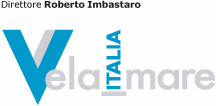IN EVIDENZA
convegni lega navale italiana optimist libri regate smeralda 888 yccs foiling week vele d'epoca federvela class 40 imoca 60 rc44 altura uvai ambiente
CATAMARANI
Hydros announces that construction has begun on its yacht for the Little America's Cup

Roberto Imbastaro
The catamaran that will compete in the Little America's Cup under the Swiss flag in September 2013 is currently under construction at the Decision SA shipyard. It will benefit from innovative Swiss technology that has never previously been used on a yacht.
Morges, July 30, 2012 – The Hydros project is entering a new phase as construction begins on the catamaran that will be entered for the Little America's Cup. The catamaran was designed by architectural firm VPLP, which is working exclusively with Hydros on the project, with the aim of winning the legendary race to be held in the United Kingdom in September 2013.
Two versions of the catamaran are being built by the Décision SA shipyard in Ecublens, so that the sailing team will be able to test and compare different configurations of foils and centerboards. The construction process is innovative and completely new: both catamarans will be built using thin ply technology (TPT), a technique invented on the shores of Lake Geneva that has already been used in Formula 1 and on a number of wing masts for the forthcoming America’s Cup, but which has never previously been employed in yacht construction.
As Gilles Rocher, Head of Marketing at North TPT, explains: "This process allows us to use exactly the right amount of material in the right place and in the right way, thereby optimizing the yacht’s structure and markedly improving her performance."
Meanwhile Bertrand Cardis, Head of the Décision SA shipyard, is of the opinion that "the construction method has more in common with aeronautics than traditional racing yachts. We fine-tuned this technique when we built the second plane for Bertrand Piccard, and we are now going to use it in the construction of the hulls, beams and wing mast of the Hydros catamaran."
The first boat – a masterpiece of high technology – will be launched at the end of the year, and the second version will follow two months later. The name of its skipper, an internationally famous sailing champion, will be announced at the end of the summer break. The selection procedure for the second yacht will begin at the end of the summer, with the aim of recruiting a first-rate Swiss crew.
"This is a thrilling project because it brings together so many of the elements we value, such as high technology, competition and the pioneering spirit," says Thierry Lombard, who spearheaded the Hydros project. "We are very proud to be behind the first yacht in history constructed out of TPT. We are delighted to see the project take shape and to be competing in the Little America’s Cup regatta next year."
The Hydros project has three main components: a yacht flying the Swiss flag being entered for the Little America's Cup, the “Défi des Grandes Ecoles” (university challenge) and the catamaran l’Hydroptère.ch, which recently broke the one-hour record on Lake Geneva and achieved the best time since 2007 on the Blue Ribbon course, smashing the record by covering the stretch from Geneva to Le Bouveret in 1 hour 44 minutes.
Right from when it first took place in 1961, the Little America's Cup has symbolized fundamental research and ground-breaking technological development, on a human scale. The yachts, which have a crew of two, must measure a maximum of 7.62 m x 4.20 m, with a sail surface area of no more than 27.8 m2. These restrictions are precisely what makes the class so exciting, since the yacht designers are forced to explore cutting-edge techniques. Furthermore, these boats have been sailing with wing masts for over thirty years!
Switzerland has all the necessary skills at its disposal to win the trophy; our aim is to bring them together to achieve this ambitious objective.
30/07/2012 11:39:00 © riproduzione riservata
Tweet
CORRELATI
DELLA SETTIMANA
Viareggio-Bastia-Viareggio: Line Honours per Arca SGR
Alle ore 8. 02’ 46’’ di oggi, venerdì 27 giugno, dopo circa 145 miglia percorse, il maxi 100’ ARCA SGR timonato dallo skipper triestino Furio Benussi con il Fast and Furio Sailing Team, ha tagliato per primo in tempo reale
Un "Cavallino Rampante" per Giovanni Soldini
Innovazione, performance ed efficienza rappresenteranno il nuovo progetto sportivo di Ferrari che con Hypersail molla gli ormeggi verso la vela oceanica. Un progetto che si presenta come una sfida tra tradizione a innovazione tecnologica
Partito l'Italiano d'Altura a Capo d'Orlando
Tre prove portate a termine dalle due flotte con vento dai 7 ai 11 nodi. Le prime classifiche: subito i favoriti in evidenza, ma occhio alle sorprese
Italiano Altura: si regata a Capo d'Orlando
La cerimonia di apertura del Campionato Italiano Assoluto di Vela d’Altura Edison Next a Capo d’Orlando, in Sicilia. Regate dal 25 al 28 giugno: 33 barche in corsa per i titoli italiani
Proseguono gli arrivi alla viareggio-Bastia-Viareggio
Il Vismara Momi 80 di AngeloMario Moratti e Nicola Minardi de Michetti ha tagliato il traguardo alle 17.15'45’, il Farr 52 Lucifero di Giordano Cardini e Nanni Lombardi alle 17.53’18’, e il 50’ K9 dell’armatore Gianluca Giurlani alle ore 19. 22’36’’
Foling Week: subito al massimo
La prima fase di regate ha registrato numeri da record: 131 atleti iscritti nei WASZP, la partecipazione più alta di sempre alla Foiling Week per questa categoria, e 32 barche in acqua per la flotta Switch One Design, la più numerosa mai riunita in regata
Partito il Campionato del Medio Adriatico Hansa 303
Doppio podio della Liberi nel Vento che ha partecipato con tre equipaggi: Tommaso e Matteo Ferranti, Luna e Giovanni Di Biagio (nella foto), Claudia Benzoni e Daniele Malavolta
Filiera ittica: l'impegno di Bolton, WWF e Oxfam
Presentati i risultati concreti raggiunti nell’ambito delle partnership trasformative per una pesca più sostenibile, per la salvaguardia degli oceani e per la tutela dei diritti umani lungo tutta la filiera produttiva.
Luca Rosetti e Matteo Sericano al via della Les Sables-Horta-Les Sables
Una sfida atlantica che vedrà Luca Rosetti navigare inizialmente in doppio con Matteo Sericano, per poi affrontare in solitaria il ritorno: una prima assoluta che segna l’esordio in oceano aperto del navigatore italiano e della sua barca
Mancano ancora i decreti attuativi alla legge "Salvamare"
Dei circa 12 mila pescherecci presenti in Italia, i 2 mila cosiddetti a strascico durante le attività di pesca ogni anno raccolgono circa una tonnellata di rifiuti che non possono però depositare a terra, se non a proprie spese
